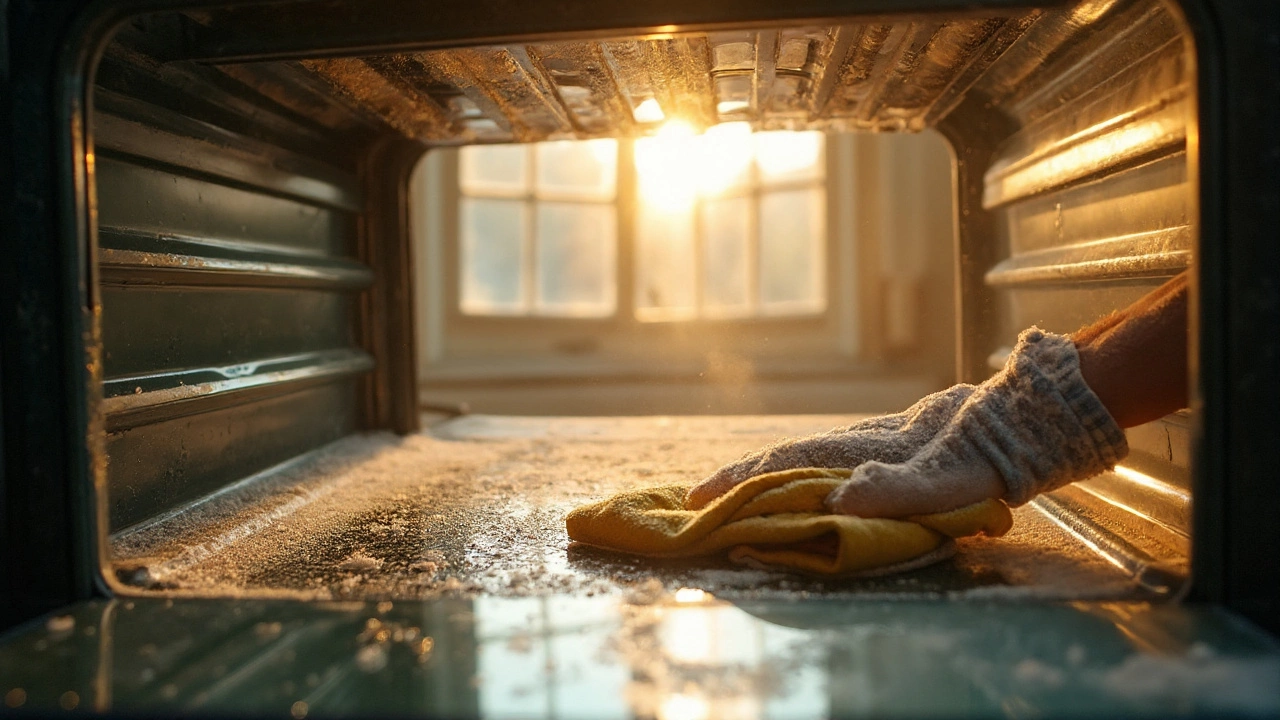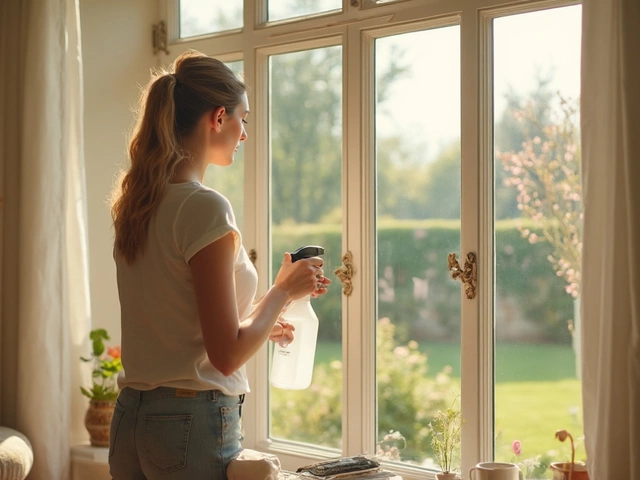Thinking about scrubbing your oven with store-bought chemicals but hate the smell or worry about what’s left behind? It’s amazing how much gunk collects down there, and the burned-on grease buildup always seems to resist every scrub and wipe. A good kitchen hack can make all the difference. The mix of Dawn dish soap and vinegar has become a legend online for cleaning just about everything, but ovens are a special beast. So, is it hype or does it really do the trick? Here’s the answer you need, plus real tips that will save your time, sanity, and maybe your clothes from another food volcano disaster.
Why People Use Dawn and Vinegar to Clean Their Ovens
Right off the bat, Dawn and vinegar look like an odd couple, but there’s method to the madness. Dawn, famous for being tough enough to clean oil-covered wildlife, can cut through most greasy messes. Its main power comes from surfactants, which grab oil and help wash it away. Vinegar brings acidic might, which helps dissolve mineral deposits, cuts through light rust, and loosens food stuck to oven walls or glass. On their own, these two staples do plenty of heavy lifting, but team them up and they turn into a cleaning force, as long as you use them correctly.
Here’s something interesting: According to the American Cleaning Institute, dish detergents like Dawn remove oil-based soils far more effectively than most general-purpose cleaners. Vinegar adds the acidity to tackle anything alkaline—think of those baked-on spills or the white haze that sometimes appears inside the oven window. Yet, you want to be careful: if you pour them together into one bottle, you don’t get superpowers, just a watered-down, less effective mess as they neutralize each other. The trick is to use Dawn and vinegar in layers or separate steps. That’s where most online tutorials get tripped up. Vinegar by itself has about 5% acetic acid, and while it’s great at cleaning, it doesn’t kill every germ—but, in an oven, you mostly care about breaking up gunk, not disinfecting for surgery. People prefer Dawn and vinegar for two big reasons: they’re cheap, and you’re not left with nasty fumes that linger for days. If you have allergies or small kids at home, you probably know how bad oven cleaner smells can hit the back of your throat days after you use them.
Another thing: Store-bought heavy-duty oven cleaners are often packed with sodium hydroxide or potassium hydroxide. Both are strong, caustic, and corrosive. They obliterate grease, yes, but breathe too much or let it drip on your skin, and you’re headed for discomfort or worse. That’s why folks with sensitive skin or respiratory issues reach for the blue bottle and the vinegar jug. Environmental impact matters too—Dawn and vinegar don’t release volatile chemicals into the air and won’t damage water systems in the same way as harsher products. According to a survey by the Environmental Working Group, about 70% of people want safer cleaning alternatives, especially when it comes to kitchen areas.
Now, are there limits? Sure. You’re not going to dissolve carbonized, years-old gunk embedded in every corner without some elbow grease—and you definitely shouldn’t mix this combo with bleach or ammonia (dangerous fumes alert). Otherwise, for regular oven maintenance, or even a deep seasonal cleaning if you keep up with it, the Dawn and vinegar route is a practical choice.
| Cleaner | Average Cost per Use | Odor | Non-Toxic? |
|---|---|---|---|
| Dawn + Vinegar | $0.80 | Mild | Yes |
| Commercial Oven Cleaner | $2.40 | Strong | No |
| Baking Soda Paste | $0.25 | Almost none | Yes |

Step-by-Step: How to Use Dawn and Vinegar for Oven Cleaning
This isn’t rocket science, but there’s a smart way to dodge frustration (and getting blue suds down your sleeve). Here’s how to do it without making a bigger mess:
- First things first—empty the oven. Racks, pizza trays, any old foil—out they go.
- Mix up your cleaner. For grimy ovens, squirt about two tablespoons of Dawn into a spray bottle, then add about half a cup of warm water. Shake gently, so you don’t end up spraying a bubble storm everywhere.
- Spray down the oven interior, concentrating on greasy patches, the window, and anywhere you see baked-on drips. Let it sit for 30 minutes. Don’t rush this part—time does the heavy lifting.
- Now, fill a separate spray bottle with straight white vinegar. You don’t want to mix the Dawn with vinegar just yet.
- After 30 minutes, use a damp, soft sponge or rag to wipe away most of the Dawn and loosened mess. Don’t scrub first—just wipe. The gunk should start coming up.
- Spritz stubborn spots with vinegar. You’ll see some fizzing where soap residue or leftover grime reacts with the acid. This is totally normal and helps break anything loose that’s clinging on.
- Wipe again with a damp sponge. Use a plastic scraper for tough bits—never anything metal. You don’t want to scratch the enamel.
- Once it looks reasonably clean, rinse your cloth and wipe the whole oven interior with clean water. This prevents any soap or vinegar from being left behind (nobody wants mystery flavors in their next dinner).
- If you want, do a second spritz with vinegar and buff with a microfibre cloth to leave the glass door streak free.
- Leave the door open to dry out. Replace your racks—or, better yet, wash those in your tub with leftover Dawn for a full cleaning day.
Real talk—if your oven has ancient, blackened stuff that looks fossilized, you’ll need to repeat this process a couple times. Don’t forget the oven window: the mix works wonders here. For the racks, soak them in hot water mixed with Dawn and a cup of vinegar, then scrub using a non-metal scrub pad. For self-cleaning ovens, skip all this; use the self-clean function, then spot clean sticky spots with the same Dawn and vinegar process once the oven is cool. Never use abrasive pads on the oven’s enamel if you care about keeping it looking good.
Baking soda can also join this cleaning party. If you’re faced with baked-on disasters, sprinkle a little on problem spots after the Dawn has done its soak. This gentle abrasive boosts the effect without scratching. Vinegar and baking soda will react with a satisfying fizz, helping break things up further.
And the power of patience? It works. The biggest enemy of this method isn’t weak cleaner; it’s not letting things soak long enough. If you’re in a rush, you’ll just end up scrubbing till your arm is sore. Let time and chemistry do the grunt work, and you’ll save yourself a lot of sweat.
One more thing—ventilation matters. Vinegar isn’t dangerous in small amounts, but the strong smell can still make eyes water, especially in tiny kitchens. Crack a window or run a fan just to stay comfortable.
For everyday maintenance, a little Dawn and water on a cloth after each use can keep your oven from ever getting wild in the first place—no need for marathon cleanings if you spend 3 minutes wiping while things are warm (but not hot).
“Proper oven maintenance with mild detergents and household acids like vinegar keeps appliance surfaces both clean and safe for food. But don’t expect magic without elbow grease.” — Good Housekeeping Institute, Cleaning Lab Director

Tips, Facts, and How Dawn and Vinegar Stack Up Against Other Methods
If you like data—and who doesn’t like a little proof before diving in—here’s what separates this method from the classic options. According to an April 2023 survey from Good Housekeeping, 64% of people choosing to clean with Dawn and vinegar said they preferred it for the lack of harsh fumes, while 48% liked being able to use tools they already had at home. About 55% reported needing to repeat the process once or twice for heavily stained ovens, but nobody mentioned damage to the enamel or seals.
When it comes to pure cleaning strength, nothing competes with caustic spray-on oven cleaner. However, it’s rare that homes need that level of firepower more than a couple times a year, usually after Thanksgiving or a big get-together. For regular folks who just want things tidy, Dawn and vinegar hit a nice sweet spot: they’re safe, cheap, you can grab them in any grocery store, and the process is easy enough for even the most distracted cook. The absence of lye or chlorine bleach in your kitchen cannot be underestimated if you have pets or kids underfoot. Dogs and cats get into everything, and a kid’s fascination with shiny oven doors is a problem when you use harsh sprays that linger.
This combo has its quirks. You won’t get fancy scents—Dawn and vinegar will leave things smelling neutral or slightly like pickles for an hour. Nothing a quick oven air-out won’t fix. Genuinely dangerous bacteria won’t survive normal oven heat cycles, so there’s no need to blast things with chemical antimicrobials. But if you’re after a shiny, grease-free look and a safer cleaning routine, this DIY method delivers. If you use cast iron or have sensitive oven seals, this approach won’t corrode sensitive parts. Most appliance manuals, including Whirlpool and GE, discourage using strong commercial chemicals inside, so Dawn and vinegar are a smarter option for most warranty policies.
Want your next cleaning to be easier? Line the bottom of the oven with a reusable silicone mat (never foil—foil messes with heat flow and risks damage). Wipe up spills when they happen. Regular touch-ups with mild soap and vinegar mean you can probably skip deep cleans for months, if not an entire year. And if you want a bit more scrubbing action without chemical grit, try a paste of Dawn and baking soda on trouble spots, rinse, then finish with vinegar; this three-step system is about as comprehensive as you can get for home cleaning without opening a hazmat suit.
One last stat for the road: In a university test of 20 common homemade and commercial oven cleaners, Dawn, baking soda, and vinegar scored within 10% of the cleaning power seen in the top commercial brand—provided users followed the soak and time directions. Not bad for something found in most kitchens already. If you’ve ever been burned by chemical oven cleaner (literally, those hand stings are rough), you know simplicity can be a game-changer. Next time the oven’s looking grimy, it’s worth giving the Dawn and vinegar trick a real run—as long as you let the science, and a little patience, do the heavy lifting.




